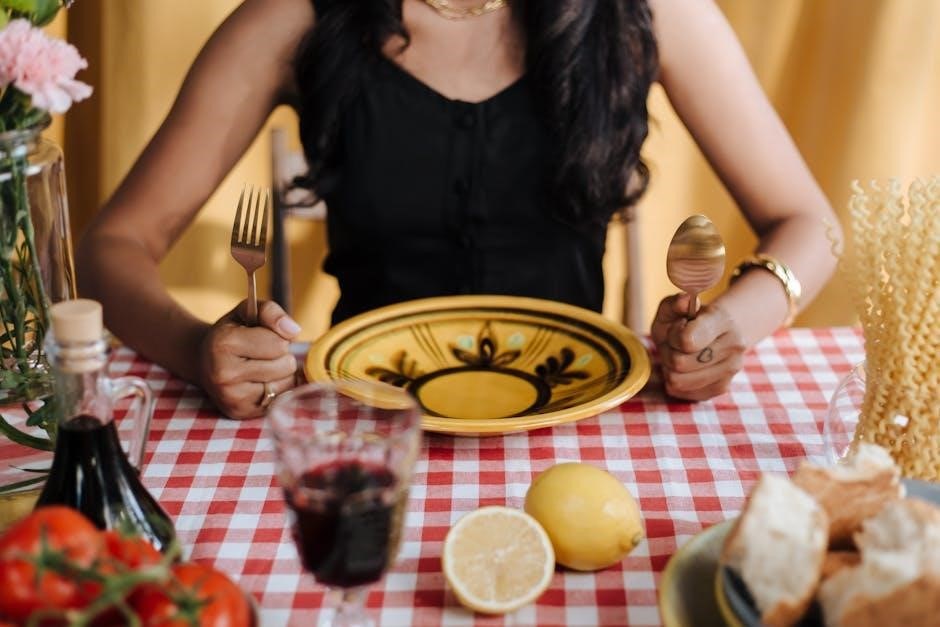Red wine, a timeless beverage with rich history, offers diverse styles from light to full-bodied. Its complex flavors, ranging from red berries to dark fruits, cater to every palate, making it a versatile choice for any occasion or meal.
History and Cultural Significance of Red Wine
Red wine has a rich history dating back thousands of years, with roots in ancient civilizations like Egypt, Greece, and Rome. It played a central role in religious rituals, medicine, and social gatherings. Its cultural significance grew through the ages, becoming a symbol of prosperity, tradition, and artistry, deeply embedded in global cuisine and celebrations.
Popular Red Wine Styles and Flavour Profiles
From light-bodied Pinot Noir, offering delicate red berry notes, to bold Shiraz with dark fruit and spice, red wines vary widely. Cabernet Sauvignon showcases blackcurrant and tannins, while Merlot provides plum and smoothness. Each style reflects unique regional characteristics, offering a diverse array of flavors to suit every palate and occasion.
Red Wine Basics: Understanding Varietals and Regions
Key red wine varietals include Cabernet Sauvignon, Merlot, and Pinot Noir, each with distinct flavor profiles shaped by their regions. Bordeaux is renowned for its blends, while Burgundy excels with Pinot Noir. Regions like Tuscany and Rioja also produce iconic reds, highlighting how terroir and winemaking traditions influence the character and quality of the wine.

How Red Wine is Made
Red wine is crafted through precise steps, from harvesting grapes to fermentation and aging, with its color and flavor derived from grape skins, enhancing complexity.

The Winemaking Process: From Harvesting to Fermentation
Red wine production begins with harvesting ripe grapes, followed by crushing to release juices. The mixture, including skins and seeds, undergoes maceration to extract color and flavor. Fermentation converts sugars into alcohol, with longer skin contact enhancing tannins and complexity. This process distinguishes red wine from white or rosé, which have minimal skin exposure.
The Role of Grape Skins, Seeds, and Oak Aging
Grape skins contribute color, tannins, and flavor compounds, while seeds add more tannins and complexity. Oak aging enhances the wine’s texture, adding vanilla, caramel, and spice notes. This process refines the wine, balancing its boldness and preparing it for long-term ageing, resulting in a sophisticated and harmonious finish.

Types of Red Wine
Red wine offers a diverse range of styles, from light-bodied Pinot Noir to full-bodied Cabernet Sauvignon, each with unique flavor profiles and pairing possibilities.
Light-Bodied Red Wines: Pinot Noir, Beaujolais, and More
Light-bodied red wines, like Pinot Noir and Beaujolais, are known for their delicate flavors and crisp acidity. Pinot Noir offers red berry notes and earthy undertones, while Beaujolais, made from Gamay grapes, is fruity and slightly floral. These wines are perfect for lighter dishes, such as salmon or poultry, and are often served chilled. Their subtle tannins make them refreshing and easy to pair with various cuisines.
Medium to Full-Bodied Red Wines: Cabernet Sauvignon, Merlot, Syrah/Shiraz
Medium to full-bodied red wines, including Cabernet Sauvignon, Merlot, and Syrah/Shiraz, are celebrated for their bold flavors and robust tannins. Cabernet Sauvignon offers blackcurrant and spice notes, while Merlot is smooth with plum and chocolate hints. Syrah/Shiraz is known for its dark fruit, pepper, and smoky undertones. These wines pair well with hearty meats, rich sauces, and robust cheeses, making them ideal for special occasions or pairing with complex dishes.
Sweet and Sparkling Red Wines: Lambrusco, Brachetto d’Acqui, and Others

Sweet and sparkling red wines, such as Lambrusco and Brachetto d’Acqui, offer a refreshing twist. Lambrusco is known for its fruity and slightly sweet profile, perfect with pizza and cured meats. Brachetto d’Acqui, a semi-sparkling wine, features raspberry and rose petal notes, ideal for desserts or romantic occasions. These wines are delightful alternatives for those seeking a sweeter, livelier red wine experience.

How to Enjoy Red Wine
Enhance your red wine experience by serving at optimal temperatures, using appropriate glassware, and decanting to soften tannins. Light-bodied wines thrive at 55°F (13°C), while full-bodied varieties shine at 60-65°F (15-18°C). Larger glasses allow aromas to unfold, ensuring a richer, more balanced flavor profile with every sip.
Serving Temperature and Glassware Recommendations
For optimal enjoyment, serve light-bodied red wines like Pinot Noir at 55°F (13°C) and full-bodied varieties like Cabernet Sauvignon at 60-65°F (15-18°C). Use larger glasses for bold wines to enhance aroma expression, while smaller glasses suit lighter styles. Proper temperature and glassware ensure a balanced flavor experience, allowing the wine’s nuances to shine.
Decanting and Aerating Red Wine for Optimal Flavor
Decanting separates wine from sediments, enhancing clarity and aroma, while aerating exposes it to oxygen, softening tannins and revealing complex flavors. Allow bold wines like Cabernet Sauvignon to breathe for 30 minutes to an hour before serving. This process ensures a smoother, more balanced taste, making the drinking experience even more enjoyable and refined.
Red Wine and Food Pairing
Red wine’s rich flavors and tannins complement a variety of dishes, from hearty meats to rich cheeses, enhancing both the meal and the wine’s complexity, creating a harmonious dining experience.
General Pairing Tips: Matching Body and Tannins to Dishes
Pairing red wine involves balancing body and tannins with dish intensity. Light-bodied wines suit delicate flavors, while full-bodied wines complement bold, hearty dishes. Tannins cut through richness, enhancing harmony between wine and food, ensuring a balanced and enjoyable culinary experience.
Classic Pairings: Red Wine with Meat, Cheese, and Chocolate
Red wine pairs exquisitely with grilled meats like steak and lamb, complementing their charred flavors. Rich cheeses, such as cheddar and gouda, are elevated by bold reds, while chocolate, especially dark, finds a perfect match in fruity, full-bodied wines, creating indulgent and harmonious combinations.

Ageing Red Wine
Properly ageing red wine enhances its complexity and balance. Store at 55°F with high humidity and minimal light. Tannins soften, while acidity maintains structure, revealing refined flavors over time.
How to Store Red Wine for Optimal Ageing
Store red wine in a cool, dark place with consistent humidity. Maintain a temperature of 55°F (13°C) to slow ageing. Use a wine rack to keep bottles horizontal, ensuring the cork stays moist. Avoid vibrations and strong odors, as these can disrupt the wine’s development. Proper storage preserves tannins and acidity, ensuring optimal ageing and flavor.
Understanding Tannins, Acidity, and Their Role in Ageing
Tannins and acidity are key components in red wine ageing. Tannins act as natural preservatives, softening over time to enhance complexity. Acidity maintains freshness and balance, contributing to the wine’s backbone. As wine ages, tannins mellow, and acidity harmonizes, revealing a refined, mature character that highlights the wine’s potential for long-term development and enjoyment.
Investing in Red Wine
Investing in red wine combines passion and strategy. Build a diverse collection, focusing on premium regions and varietals, with proper storage to enhance value and enjoyment over time.
Building a Wine Collection: Tips for Beginners
Starting a wine collection involves research and patience. Begin by exploring regions and varietals, understanding personal taste preferences. Store wines in a cool, dark place with consistent humidity. Consider consulting experts or wine clubs for guidance. Invest in quality over quantity, focusing on wines with aging potential. Diversify to create a balanced and enjoyable collection.
Key Regions and Varietals to Consider for Investment
Investing in red wine focuses on top regions like Bordeaux, Tuscany, and Napa Valley. Varietals such as Cabernet Sauvignon, Syrah/Shiraz, and Nebbiolo are sought after for their aging potential. Look for wines with high tannins and acidity, ensuring longevity. Regions like Rioja and Piedmont also offer promising investment opportunities with their iconic varietals. Research and select wines from reputable producers for optimal growth.

Health Benefits and Risks of Red Wine
Red wine contains antioxidants like resveratrol, which may support heart health and reduce disease risks. However, overconsumption can lead to negative effects, emphasizing the need for moderation.
The Science Behind Red Wine’s Antioxidants and Heart Health Benefits
Red wine’s antioxidants, particularly resveratrol, help protect against heart disease by reducing inflammation and improving blood flow; These compounds also combat free radicals, potentially lowering cholesterol and blood pressure, promoting overall cardiovascular well-being when consumed in moderation.
Moderation: Understanding the Risks of Overconsumption
Moderation: Understanding the Risks of Overconsumption
While red wine offers health benefits, overconsumption can lead to liver damage, increased blood pressure, and heightened risk of chronic diseases. Moderation is key; exceeding recommended limits negates benefits, emphasizing the importance of balance for optimal health and enjoyment.

Red Wine Tasting Techniques
Master the art of tasting with the five S’s: See, Swirl, Smell, Sip, and Savor. This method helps you appreciate the wine’s appearance, aroma, flavor, and finish, ensuring a deeper understanding of its complexity and balance of tannins and acidity.
The Five S’s: See, Swirl, Smell, Sip, and Savor
Mastering the Five S’s enhances your red wine experience. See: Examine the color and clarity. Swirl: Agitate to release aromas. Smell: Appreciate the bouquet. Sip: Taste, noting flavors. Savor: Enjoy the finish. This method helps you fully engage with the wine’s characteristics, from its appearance to its lingering notes, ensuring a comprehensive appreciation of its quality and complexity.
Developing Your Palate: Recognizing Flavors and Tannins
Developing your palate involves recognizing the diverse flavor profiles and tannin levels in red wines. Start by identifying common flavors like red berries, dark fruits, spices, and earthy notes. Tannins contribute to the wine’s structure, creating a drying sensation. Practice by tasting various varietals, noting how tannins and acidity balance the flavors. Over time, your ability to discern subtle nuances will refine, enhancing your appreciation of red wines.

Buying Guide for Red Wine
Explore various regions and varietals to find the perfect red wine. Consider personal taste, occasion, and budget. Lighter reds suit casual sips, while bold styles pair with hearty meals, ensuring a match for every preference and setting.
How to Choose the Right Red Wine for Every Occasion
When selecting a red wine, consider the occasion and pairing needs. Light-bodied options like Pinot Noir are ideal for casual gatherings or delicate dishes, while bold varietals such as Cabernet Sauvignon or Syrah pair perfectly with hearty meals. For special events, sparkling reds like Lambrusco add a celebratory touch, ensuring a match for every setting and taste.
Reading Wine Labels: Understanding Terminology and Classifications
Wine labels reveal key details about the wine. Terms like varietal (grape type), vintage (harvest year), and appellation (region) guide your selection. Descriptors like tannins and acidity indicate mouthfeel, while residual sugar notes sweetness levels. Understanding these elements helps you make informed choices and ensures the wine aligns with your preferences and pairing goals.
Wine on a Budget: Affordable yet Quality Options
Enjoying high-quality red wine doesn’t have to break the bank. Regions like Argentina, Spain, and Italy offer exceptional value. Look for varietals like Malbec, Tempranillo, and Dolcetto, which deliver rich flavors at affordable prices. Wines from lesser-known appellations or blends can also provide excellent quality without premium pricing, making them perfect for everyday enjoyment or casual gatherings.